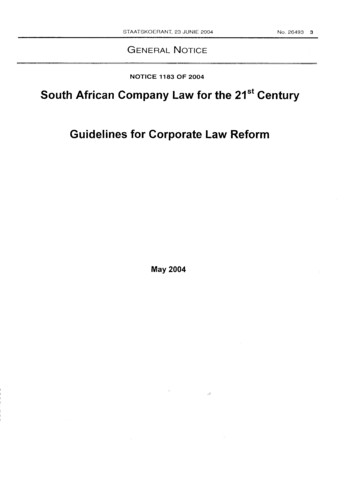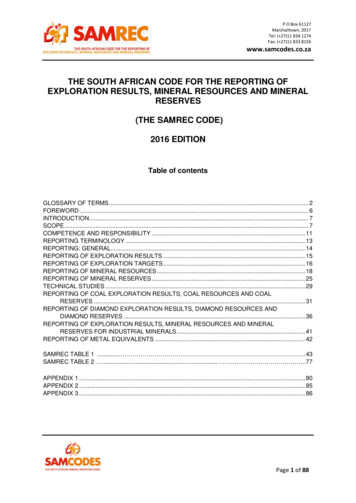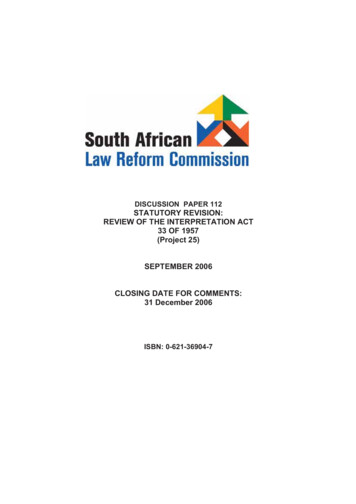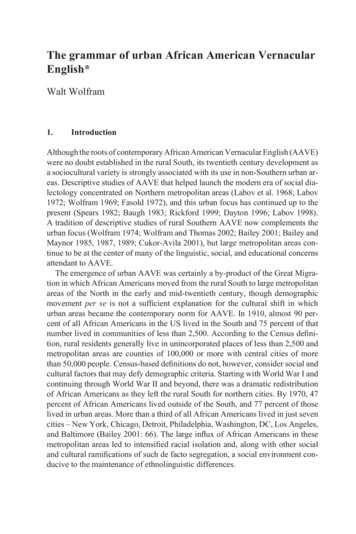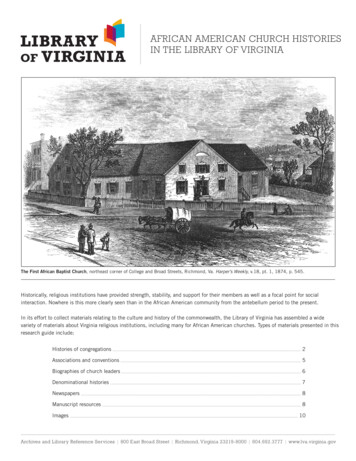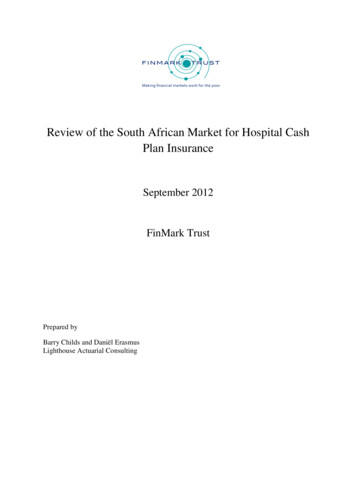
Transcription
Review of the South African Market for Hospital CashPlan InsuranceSeptember 2012FinMark TrustPrepared byBarry Childs and Daniël ErasmusLighthouse Actuarial Consulting
1Contents1.Executive Summary . 52.Introduction .103.4.5.6.2.1Research Goals .102.2Methodology and Process .11Overview and Regulation .123.1Health Insurance vs. Medical Schemes – Definitions and concepts .123.2Market Development and History .143.3Regulatory Structure .183.4Demarcation Disputes.213.5Proposed Revised Demarcation .233.6Chapter Summary .25Market Structure and Product Types for HCPs .264.1Market Size and Growth .264.2Product Providers .274.3Product Features.284.4Premiums and Persistency .344.5Target Market and distribution .374.6Profitability, Costs and Premium Breakdown .384.7Chapter Summary .41Membership .425.1The Battle for Members .425.2Membership Overlap .435.3HCP Policyholder Demographics and Trends .435.4Chapter Summary .46Analysis and Comparison Modelling .476.1The Reality – An Affordability Comparison .476.2Benefit Quantification (Private Facility) .506.3Benefit Quantification (State Facility) .54H0 Patients .55H1 Patients .55
2H2 Patients .56H3 Patients .576.47.Chapter Summary and Conclusion .59Impact of Revised Demarcation and NHI .607.1Impact of Revised Demarcation .60Level H1 – Impact of Revised Demarcation .61Level H2 – Impact of Revised Demarcation .618.7.2Considerations .647.3Expected Impact of NHI .64Conclusion .66Appendix 1 Contribution Analysis .67Appendix 2: Private Sector Benefit Value Offering Mapping (Additional Results) .69Low Cover Options .69Medium Cover Options .70High Cover Options .71Appendix 3: State Sector Benefit Quantification and Scenario Analysis.72H1 Analysis.72H2 Analysis.74Appendix 4: Scenario Analysis .76H1 Patients .77H2 Patients .80Appendix 5 .829.References .83Figures and IllustrationsFigure 1: Health Insurance General Product Overview .13Figure 2: Current Regulatory Structure .18Figure 3: HCP Benefit Classification .31Figure 4: Total Number of Lives Age Analysis .44Figure 5: Principal Member Age Analysis by Gender .44Figure 6: Income Distribution Comparison (Cover Level as Proxy).45Figure 7: Contribution Comparison .48
3Figure 8: Contributions as a Proportion of Salary.49Figure 9: Benefit Value Comparison.52Figure 10: Average LOS per Admission .53Figure 11: HCP Benefit Richness – State Facility (H1 income level) .56Figure 12: HCP Benefit Richness – State Facility (H2 income level) .57Figure 13: Impact of Revised Demarcation on HCP Benefit Richness H1 (State Facilities) .61Figure 14: Impact of Revised Demarcation on HCP Benefit Richness H2 (State Facilities) .62Figure 15: Benefit Richness Mapping (Low Cover Levels) .69Figure 16: Benefit Richness Mapping (Medium Cover Levels).70Figure 17: Benefit Richness Mapping (High Cover Levels) .71Figure 18: Distribution of Gains/Losses (H1) .72Figure 19: HCP benefit richness – State facility (H1 income level with LOS 2 days) .73Figure 20: Distribution of Gains/Losses (H2) .74Figure 21: HCP benefit richness – State facility (H2 income level with LOS 2 days) .75Figure 22: Net Gain/Loss for H1 patients .78Figure 23: Net Gain/Loss to H1 Patients (Capped benefits) .79Figure 24: Net Gain/Loss for H2 patients .80Figure 25: Net Gain/Loss to H2 Patients (Capped benefits) .81TablesTable 1: Regulatory Overview .25Table 2: Estimated Market Size.27Table 3: Benefit structure for HCP, medical scheme and gap cover products .30Table 4: HCP Benefit Comparison .32Table 5: Providers .35Table 6: Hospital Cash Plan Principal Policyholder Average Monthly Contributions .35Table 7: Income-rated Medical Scheme Principal Policyholder Average Monthly Contributions .35Table 8: Premium Breakdown per average policy .38Table 9: Premium Breakdown per Average Policy .38Table 10: Product Classification .41Table 11: Membership Demographic Summary .46Table 12: Benefit Richness .51Table 13: Hospitalisation Breakdown .52Table 14: Means Test and UPFS Rates .54Table 15: Related Costs of a Major Medical Event .55Table 16: Summary of Analysis and Comparison Modelling .59Table 17: Available Benefits .60Table 18: Required Salary per Cover Level .63Table 19: Contributions as a proportion of salary (Salary Level A).67Table 20: Contribution Comparison Scenario (Salary Level A) .67Table 21: Contributions as a proportion of salary (Salary Level B) .67
4Table 22: Contribution Comparison Scenario (Salary Level B).68Table 23: Proportional Income Summary .68Table 24: Expenses .76Table 25: Public Sector Scenario 1 Analysis .77Table 26: Public Sector Scenario 2 Analysis .77Table 27: Capped benefits (H1).78Table 28: Public Sector Scenario Analysis .81Table 29: Industry Bodies and Other Participants .82Table 30: Insurers and Reinsurers .82
51. Executive SummaryBackground to the South African health insurance market for low income earners1The funding of health care in South Africa has a long and complex history. Private medical schemesoperate as not for profit trusts and pool members’ funds to purchase private health care goods andservices. The Medical Schemes Act no. 131 of 1998 is the primary legislation governing medicalschemes while the Council for Medical Schemes (CMS) is the delegated administrative body withjurisdiction over these schemes. The majority of the income-rated options as considered in this reportprovide for benefits at 100% of the scheme rate. As this is below the charging rate of manyspecialists, income rated options often make use of provider networks and designated service provider(DSP) agreements that facilitate payment in full as long as the member makes use of the applicablenetworks. Consequently, while medical schemes offer greater protection to members, they are alsosignificantly more expensive and are thus inaccessible to the majority of the population, with only16% of the population currently being members of these schemes.In addition to health insurance products offered by medical schemes, long- and short-term insurersalso offer health insurance products. Long- and short- term insurers are governed by the Long TermInsurance Act no. 52 of 1998 and Short Term Insurance Act no. 53 of 1998, respectively, and theirprimary administrative body is the Financial Services Board (FSB). The Insurance Acts do not permitthem to be involved in the business of a medical scheme. An agreement reached in 2004 between theCMS, FSB and the Life Offices’ Association (LOA), the then industry representative body for longterm insurers, saw the release of a demarcation document to provide clarity to all stakeholders on thedefinition of the “business of a medical scheme” as defined in the Medical Schemes Act. The aim ofthe demarcation agreement was to protect medical schemes and ensure that the core principles ofsolidarity and community rating in the medical schemes environment were not undermined by therisk-rated approach of health insurance products.The provision of health insurance products by long and short-term insurers is relevant to thedemarcation issue on two fronts:1. In response to increasing prices charged by specialists for in hospital services, short-terminsurers have developed Gap cover insurance policies which provide for the shortfallsbetween medical scheme benefits and rates charged by providers. Membership of Gap coverproducts is limited to members of medical schemes, thereby providing additional cover for1Low income earners are defined for purposes of this report as the LSM 1-6 market and exclude theunemployed and people whose only income is social grants.
6those that can afford medical scheme membership but providing no protection for low incomeearners that are not members of a medical scheme. Profit margins are relatively high,although this has reduced recently as doctors and patients become more acquainted and awareof Gap cover benefits.The CMS considered Gap cover products to be non-compliant with the demarcation and in2006 challenged the validity of these products in court. They considered the fact that Gapcover products offered benefits that were directly related to the cost of treatment to mean thatinsurers offering these products were conducting the business of a medical scheme. The CMSwas concerned that these products encouraged buy-down behaviour by enticing youngerhealthier members to select cheaper medical scheme options and then to “top up” withinsurance products to provide more comprehensive cover. This option is not available to allmedical scheme members due to the risk rating and underwriting policies of these productsand as such could lead to a de-stabilisation of the medical schemes industry by reducing thecross-subsidies from younger to older members or from healthier to sicker members.Although the lower court ruled in favour of the CMS, the Supreme Court of Appeal in 2008ruled in favour of the insurer based on the interpretation of the medical schemes Act.2. In addition to Gap cover products, both long- and short-term insurers offer Hospital CashPlans (HCPs). HCPs are mainly aimed at that part of the market that does not belong tomedical schemes and are dependent on public health care services. Public health careservices are billed according to a means test and the tariffs for each income category are setout in the Uniform Patient Fee Schedule (UPFS). Only certain groups (unemployed, thosereceiving social grants) receive free care while those in higher income categories payproportionally higher fees with those earning in excess of R6,000 per month (individualincome) being charged in full. The result is that charges can be significant for low incomeearners. These costs, together with the related costs of a health event such as transport,accommodation and lost income, can result in significant out of pocket expenditure.Under HCPs, premiums are dependent on age and cover level. While hospitalisation isgenerally the trigger for payout, compensation is unrelated to the cost of the health servicesbut is instead a lump sum benefit based on number of days hospitalised and in some casestype of care. HCPs generally provide cover of between R250 per day and R5,000 per day forpremiums of between R100 and R450-R850, respectively. Some HCPs also contain add-onslike disability insurance, cash-back and the like. Given that the payout under HCPs isunrelated to the cost of care, insurers are unable to confirm how these payouts are spent (oncovering direct health expenses, on indirect expenses like transport or convalescence, or as a
7windfall). It is possible that they are used in many cases to defray the costs of health care,most likely at a public facility.The effectiveness of HCPs in meeting the cost of health careThe purpose of this paper is to analyse the effectiveness of HCPs in meeting the cost of health care forlow income-earners. There are estimated to be between 1 million and 1.5 million policies in effect,with total lives covered estimated to be 27% of those covered under medical schemes, or 2.4 millionpeople. The majority of policyholders are in the LSM2 4-7 brackets3, and more than 55% of HCPbeneficiaries are concentrated between the ages of 20 - 40 years. There are between 30 and 40insurers providing HCPs, versus 99 medical schemes and between 15 and 20 Gap cover providers.While the benefits of a HCP are not comparable to those of a medical scheme, low-income SouthAfricans would likely have no alternative product which they could access due to affordabilityconstraints.HCP products are less expensive than the cheapest open income-rated medical schemes for most agesand cover levels. The reason for the relative affordability of HCPs is that they have significantly lowerbenefit levels. HCPs also apply relatively light underwriting conditions, this due to the relativeexpense of underwriting at such low premium levels.Our analysis in this paper illustrates that HCPs are able to offer some form of protection against bothdirect and indirect costs to low income (less than R 6,000 per month) earners that make use of publicfacilities even at benefit levels as low as R 500 or R 1,000 per day. At income levels as low asR 3,000 per day the higher relative state subsidy would imply that these products would be even morebeneficial.Suppliers’ perspectiveFrom a medical schemes perspective, one of the key concerns regarding the HCP market is the risksposed to medical schemes, but while HCPs are significantly less expensive, even high benefit coverlevels of R 3,000 to R 5,000 do not come close to covering private sector hospital costs in the samemanner as medical scheme products do. Considering that the majority of HCP policyholders also havelower levels of cover (70% to 80% of the market are believed to fall below R 1000 per day), the2LSM refers to the Living Standards Measure as developed by the South African Advertising ResearchFoundation (SAARF) and is the most widely used tool for categorising the South African population.3According to the FinScope South Africa survey 2012, the average personal monthly income for the LSM 4category is R975 and that for LSM 7 is R4080, implying that the current user base would be people earningroughly in these bands. Note, however, that the LSM categorisation is not drawn up on an income basis, butreflects various socio-economic variables including asset ownership and geographical spread.
8current marketing and disclosure requirements as well as the required up front lump sum depositsrequired for an uncovered individuals to attend a private facility, it is highly unlikely that the averageHCP product offering in this market would be able to draw members away from medical schemes.As for HCP writers, the market is relatively large and rapidly growing with an estimated 50,000 newpolicies sold every month. Products seem to be profitable with risk costs assumed to be between 20%to 35% of the total premium and, while lapse rates and initial expenses can be high (20% - 30% firstyear lapses), this is not out of the ordinary compared to other short term insurance products.Underwriting costs and fraud represent a challenge to this industry and, with limited sharing ofinformation and institutional market data available, this is likely to remain a key concern.The future of HCPsAs a direct (if delayed) response to the aforementioned court case, on the 2nd of March 2012 theNational Department of Health in conjunction with the CMS and FSB released a discussion documentfor public comment outlining a proposed revised demarcation between medical schemes and healthinsurance providers. The proposed revised demarcation sets out the changes to the Long TermInsurance Act and Short Term Insurance Act that would directly impact all existing health insuranceproducts. In particular, the demarcation provides that the benefits of health insurance products cannotbe related to the cost of treatment (this is not a change per se but rather a re-emphasis andclarification) and that daily HCP benefits are to be capped at 70% of daily income (net of tax) of thepolicyholder. It further provides for underwriting for health insurance products.While the majority of HCPs provide benefits that are unrelated to the cost of care and thus would notbe significantly impacted by the first requirement, Gap cover products certainly would be. Moreworrying for low income earners, is the negative effect the cap on daily cash benefits to 70% of thepolicyholder’s income will have on the value that these products are able to offer. While it appearsthat an attempt is being made to reclassify HCPs as income replacement with the proposed cap beingintroduced to prevent fraud, our analysis shows that at a monthly salary of under R3,000, the capwould limit daily benefits to a maximum of R105 while at income levels of between R3,001 andR6,000 the cap would limit daily benefits to a maximum of R210. The effect is that these productswill be unable to defray the costs of either direct or indirect medical expenses for hospitalisation atstate facilities, making them unattractive to low income earners. Further, in order to provide dailycover of over R2,000, a person would need to earn over R57,100 per month while for daily cover ofR5,000 income of R142,850 per month would be required. People in these income brackets would beable to afford medical cover, so that there would be little market for HCPs at either the low or higherincome levels.The proposed National Health Insurance (NHI) may also reduce the need for HCPs in that one of theproposals is that patients will not be required to pay for services at the point of treatment. While this issubject to debate, if there are no user fees this would significantly decrease the potential out of pocketburden faced by patients, and in turn decrease the need for HCPs. Similarly, if no co-payments arerequired for health care services, the need
beneficiaries are concentrated between the ages of 20 - 40 years. There are between 30 and 40 insurers providing HCPs, versus 99 medical schemes and between 15 and 20 Gap cover providers. Whi


